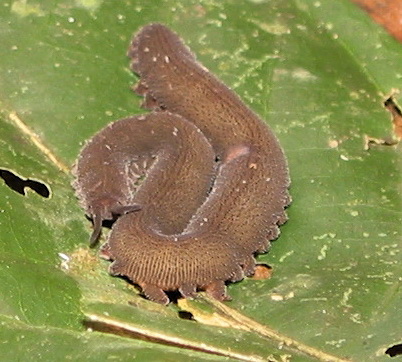Velvet Worm (Phylum: Onychophora) - Wiki Velvet worm
From Wikipedia, the free encyclopedia
[Photo] Velvet Worm (Onychophora) from the Amazon Rain Forest in Peru. Photograph taken by Thomas Stromberg, July 2002.
Onychophora, the velvet worms (occasionally called walking worms or spitting worms), are segmented, caterpillar-like, terrestrial animals somewhat resembling both arthropods and annelid worms. They are generally regarded either as a class of arthropods or as a separate phylum (in which case they are the only animal phylum to include no known marine species). About 200 modern species are known separated into two families, with 10 genera ??? Peripatidae, found in many tropical and subtropical regions worldwide including Mexico, Central America, South America, and Africa, and Peripatopsidae, found in Chile, South Africa, Australia and New Zealand. Modern species are fairly small; at least one species reaches lengths of 20 cm (8 inches). The best known modern form is Peripatus which was described by Guilding in 1825.
Description
Onychophores are apparently descended from some segmented form but have lost their overt segmentation except for the head which is composed of three segments. There are two antennae on the first head segment and usually a pair of eyes. The second head segment has a mouth. Unlike arthropods, the animal does not have a stiff exoskeleton. Their skin (cuticle) is covered with fine hair (papillae) giving a velvet-like feel and accounting for their popular name of "velvet worms". The cuticle is shed periodically to allow growth. Although the body has several dozen repeated leg pairs, it is not actually segmented like annelids. The true coelom, like that of arthropods, is restricted almost entirely to the gonadal cavities. The hemocoel is also arthropod-like, being partitioned into sinuses, including a dorsal pericardial sinus. The entire structure is supported by blood pumped by a heart. Legs are tipped by chitinous claws and walking pads used on smooth surfaces. Onychophores breathe through passages in the skin called trachea which are always open. As a result, all known species require a humid environment to avoid desiccation.
Behaviour
Modern onychophores are predators that are able to immobilize animals several times their own size with an adhesive substance that they eject from glands in their head. They can immobilize targets up to 30 cm (12 in) away, and carry a quantity of fluid of as much as 10% of their body weight.
Velvet worms have an unusual method of transferring sperm. The male onychophore attaches a sperm packet to the female. They tend to be fairly indiscriminate where on the female they attach the packet. The tissue beneath the packet dissolves and the packet melts into the female's body. The sperm swim through the hemocoel to the ovaries. Velvet worms are live-bearers, and care for their young after birth.
Evolution
Onychophores are thought to be closely related to the arthropods. The structure of their brains is similar to spiders, raising the possibility that they are most closely related to arachnids, though molecular analysis contradicts this. Possible marine onychopores are known from the Lower Cambrian ??? Aysheaia, Hallucigenia ??? and possibly the late Pre-Cambrian ??? Xenusion. A single fossil terrestrial species, Helenodora inopinata, is known from the Pennsylvanian of Illinois, another one by the name of Cretoperipatus burmiticus from the Cretaceous of Myanmar and some Tertiary specimens are reported from Caribbean amber.
The similarity of these creatures to caterpillars is not purely coincidental; as with most creatures, the larval stage of moths and butterflies are thought to represent, however inconsistently, previous evolutionary stages. Arthropods are thought to have evolved from a multi-segmented animal not entirely unlike both onychophores and caterpillars. In fact, the characteristics of larval insects are part of the evidence cited to support models of insect ancestors, for example in justifying how many segments and legs such creatures are thought to have had, many of which evolved into other parts on modern insects, like antennae and mouthparts.
Classification
Phylum: Onychophora Classis: Onychophorida Ordo - †Paronychophora Familiae: †Onychodictyidae - Genus: †Onychodictyon Ordo: Euonychophora Familiae: Peripatidae - Genera: †Cretoperipatus - Eoperipatus - Epiperipatus - Heteroperipatus - Macroperipatus - Mesoperipatus - Oroperipatus - Peripatus - Plicatoperipatus - Speleoperipatus - Typhloperipatus Familiae: Peripatopsidae - Genera: Acanthokara - Aethrikos - Akthinothele - Anoplokaros - Austroperipatus - Baeothele - Centrorumis - Cephalofovea - Critolaus - Dactylothele - Dystactotylos - Euperipatoides - Florelliceps - Hylonomoipos - Konothele - Lathropatus - Leuropezos - Mantonipatus - Metaperipatus - Minyplanetes - Nodocapitus - Occiperipatoides - Ooperipatellus - Ooperipatus - Opisthopatus - Paraperipatus - Paropisthopatus - Peripatoides - Peripatopsis - Phallocephale - Planipallipus - Regimitra - Ruhbergia - Sphenoparme - Symperipatus - Tasmania - Tasmanipatus - Tetrameraden - Vescerro - Wambalana Familiae: Incertae Sedis - Genus: †Helenodora
http://en.wikipedia.org/wiki/Velvet_worm
| The text in this page is based on the copyrighted Wikipedia article shown in above URL. It is used under the GNU Free Documentation License. You may redistribute it, verbatim or modified, providing that you comply with the terms of the GFDL. |
